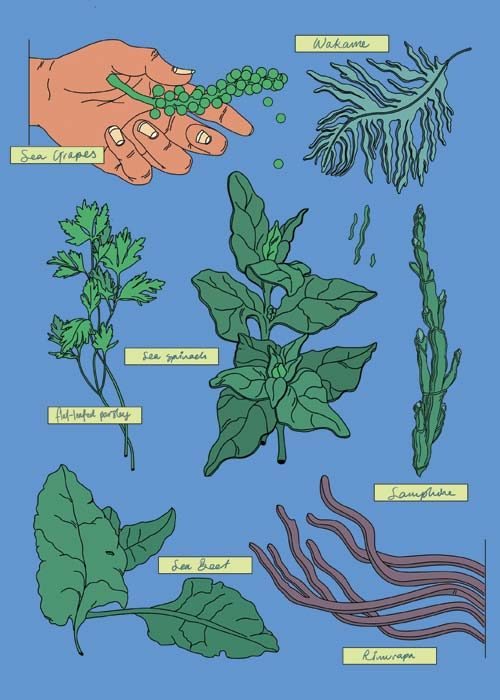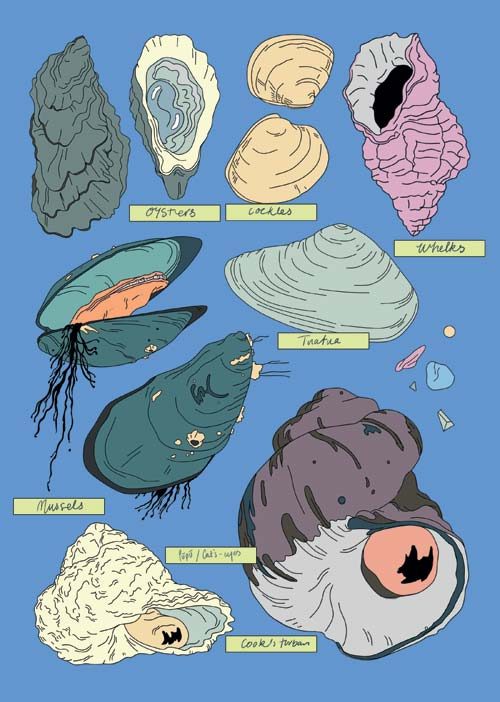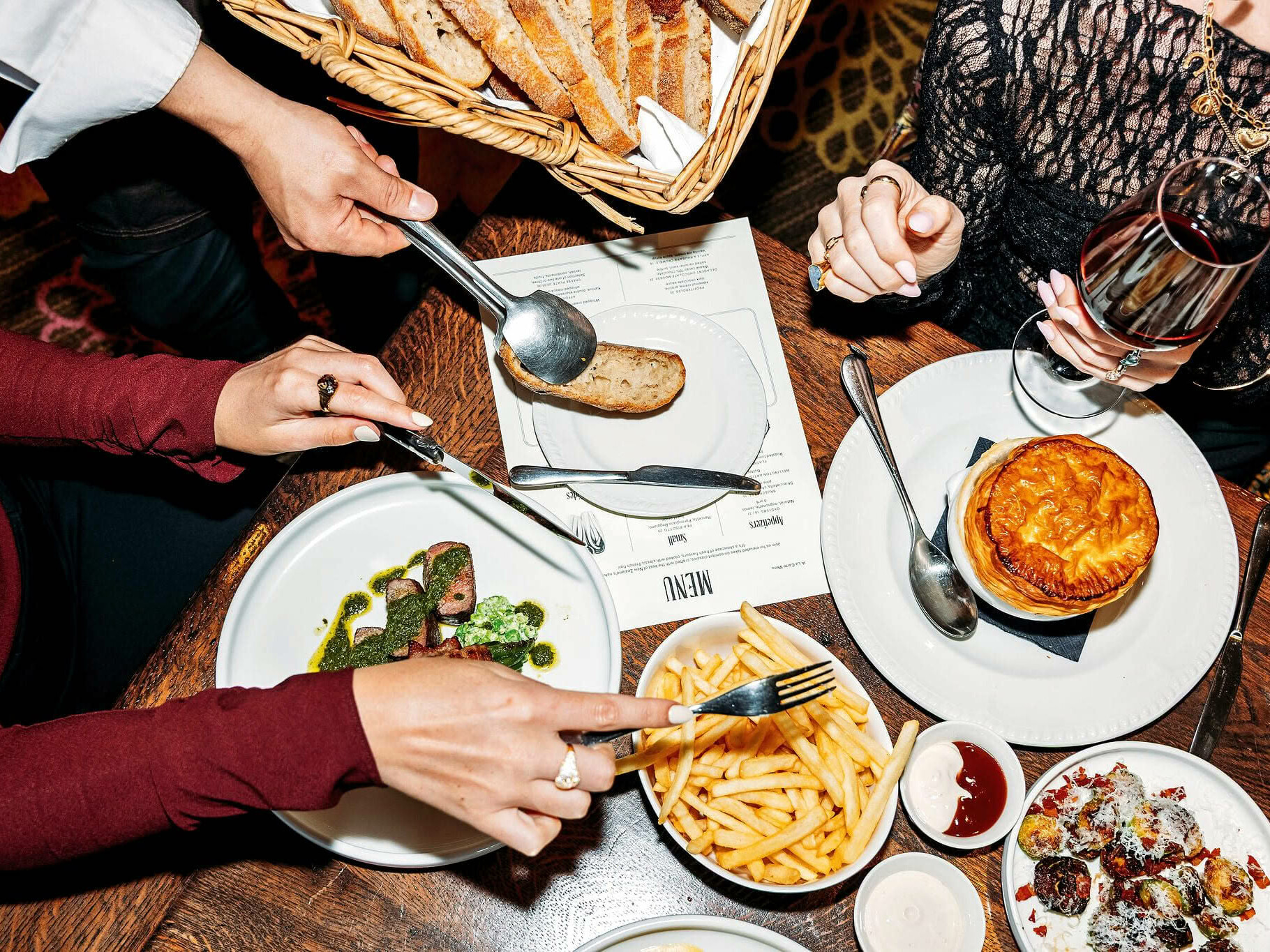DAVID BURTON FORAGES OUR PLENTIFUL COASTS TO SHOW US WHAT’S EDIBLE AND WHAT’S TRULY DELICIOUS.
SEAWEED
Looking at the swathes of seaweed everywhere you’d think that’s a good place to start. After all, all 600 of New Zealand’s seaweeds are edible except one, the stinking, sulphuric acid-ridden acid weed (Desmarestia firma) – and even that, if eaten, would cause severe indigestion rather than death.
However, just because our seaweeds are edible, it by no means follows that they are all delicious. Take, for example, one of our most common seaweeds, Neptune’s necklace (Hormosira banksii). Flight Lieutenant Hildreth in his 1962 classic, How to Survive in the Bush, on the Coast, in the Mountains of New Zealand claims optimistically that its texture when raw “is somewhat like celery without the fibre.”
Well, maybe, if you’d been shipwrecked for a month. Pluck a bunch from the rocks, munch hard and make up your own mind as to whether your mouth is now filled with a delectable celery substitute, or just salty sawdust. Although I usually spit it out, I do concede that Neptune’s necklace might prove jolly useful after the Apocalypse.
A little further up the palatability scale are karengo and sea lettuce. Karengo (Porphyra columbina) is related to Japanese nori and was an important food source for pre-contact Māori, although North Island karengo is regarded as inferior to that found around Kaikoura. Before the 2016 earthquake closed these beds to commercial harvest, Kaikoura karengo was dried and sold. However, its pungent iodine odour put many off approaching it with much enthusiasm.
At least sea lettuce (Ulva lactuca) has the virtue of smelling inoffensive. After eight minutes boiling, it emerges still brilliant emerald green in colour, softened, and with its raw ozone flavour somewhat muted. Sprinkled with soy sauce and sesame oil to bolster the blandness, it, too, would serve brilliantly as survival food. I do concede, however, that once dried and crisped it does taste markedly better.
So what, then, are the genuinely delicious fresh seaweeds? To my mind, the ultimate test is whether or not our contemporary restaurant chefs see fit to incorporate them into their menus.
SEA GRAPES
The culinary highlight of my first trip to Samoa occurred at a posh restaurant in Apia, when a fillet of fish arrived adorned with a single exquisite, miniature bunch of raw limau fuafua (Caulerpa racemosa) or sea grapes. Limited patches of our own even smaller sea grapes (Caulerpa sedoides) are found in isolated rock pools at the lowest low tide in Cook Strait, and along the North Island’s east coast. The bright green bunches taste far nicer than the dark khaki specimens. Treat them as a garnish and simply rinse them in fresh water to enjoy their crunchy, salty, cucumber-like deliciousness. Don’t try to cook them or they will melt.
WAKAME
If you’ve ever enjoyed a bowl of miso soup and noticed fragments of leaf floating in the broth, then you’ve eaten wakame. We know our wakame (Undaria pinnatifida) is identical to that found in Japanese waters, since the seaweed arrived here on the hulls of Japanese fishing boats. Having established itself in Wellington harbour in 1987, it then spread around our coastlines with alarming rapidity, much to the concern of DoC, which called it Undaria and labelled it ‘The Alien Invader’, spending millions of dollars in a fruitless attempt to eradicate it. However, wakame hasn’t proven quite such a pest as was initially feared and is often found attached to ropes, poles, jetties and other man-made structures. Some 10 or 12 types of wakame now grow in our waters, though some of them are thick and tough, so go for the thin cabbage-like varieties. Remove and discard the central stalks, boil until the leaves change from khaki to emerald green (only about 30 seconds) before shredding them and dressing them Japanese-style with sesame oil, rice vinegar tamari and mirin. Serve with cucumber as a salad.
RIMURAPA
Also known as bull kelp, rimurapa (Durvillaea antarctica) has a myriad of industrial uses, including fertiliser, stock feed and as a gel for ice cream manufacture. The dried granules are also sold as a culinary sprinkle and chef Peter Thornley has put these to elegant use as a black crust for thick slices of salmon. But from a forager’s point of view, the best use for the giant blades of the rimurapa is as a cooking pouch for infusing umami flavour into a whole fish, a time-honoured Māori technique. Make slit down one side and slide your hand in to open up the bag. Insert the fish, place a stone inside to keep it in, then cook in the embers of a fire until the kelp pouch turns black. Flip it over and cook briefly on the other side.
COASTAL PLANTS
Like seaweeds, the plants growing along our coastal edges offer a spectrum of delectability. Many of these green leaves are edible but taste unpleasantly bitter. To my taste, wild fennel is far too overpowering. The succulent leaves of the ice plant family are OK when very young, but soon grow unpleasantly tannic. Taupata berries are sweet but seed-ridden. And while we might very much enjoy the steamed leaves of New Zealand spinach (Tetragonia teragonioides), it doesn’t much like us: the plant’s harmful oxalic acid is capable of taking calcium and magnesium from our bodies, so it’s best not to over-do it. There are, however, four benign beauties:
FLAT-LEAVED PARSLEY
Most foodies agree that flat-leaved parsley (Italian parsley) is tastier than the curly-leaved parsley found at the supermaket. The good news is that wild flat-leaved parsley is widespread along the coastal edges and headlands of central New Zealand, at zero dollars a bunch.
SAMPHIRE
Strictly speaking, our seaside succulent is glasswort (Salicornia australis), but since it looks and tastes like English samphire, the name has stuck. In England a cottage industry exists to gather samphire from the East Anglian marshes, destined for the tables of exclusive London restaurants. Blanch the knobbly stalks in boiling water for 30 seconds to turn them bright green and use tiny amounts as you would capers, to garnish fish and seafood. While best in spring, it’s still okay as late as autumn.
SEA SPINACH
This is the name some foragers give to wild silver beet (Swiss chard), which being ready salted by coastal mists, tastes even better than our back-garden staple.
SEA BEET
Also similar to spinach, sea beet (Beta vulgaris maritima) has leaves that are rounded and shiny.
SHELLFISH
While crayfish, scallops, pāua and kina belong more to the realm of diving and snorkelling, I’d rate eight shellfish as worthy of the foraging landlubber.
OYSTERS
The holy grail of the coastline forager would have to be oysters – either our sweet native rock oyster or our friendly foreign invader, the Pacific oyster. Up a remote sea arm of D’Urville Island, I once found Pacific oysters grown to the size of saucers.
PŪPŪ
Try foraging the pūpū (cat’s-eyes) which abound on our rocks in the intertidal zone. Barbecue or boil for 5–10 minutes, until you can extract the flesh with a skewer. Be sure to remove the bitter, gritty digestive tract and you are left with a delicious morsel which tastes somewhat like pāua.
PIPIS & TUATUA
Belonging to the same family as the aristocratic toheroa, pipis and tuatua are probably as close to this legendary (and now protected) species as most of us are going to get. Contemporary chefs seem fond of serving tuatua raw, but to my mind they’re too tough for that. Leave them overnight in sea water to encourage them to spit out their sand, then place the whole shells over the barbecue or the embers of a fire until they pop open.
WHELKS
Often found alongside pūpū, whelks should be boiled and also rid of their guts. The white part is chewy but marvellous, tasting much like tuatua.
COOK’S TURBANS
While rarer than pūpū, this large turban-shaped shell also clings to our coastal rocks and like pūpū and it, too, tastes like pāua. Again, you have boil or barbecue them to coax out the sizeable lump of flesh with a skewer and, again, you should remove and discard the bitter, gritty digestive tract before eating.
COCKLES
Strictly speaking, our so-called cockle is a little-necked clam – and certainly they behave like the Italian clam (vongole) when steamed open with white wine and tossed with spaghetti, garlic, parsley and a smidgen of chilli.
BLUE-LIPPED MUSSELS
While our mussel farming industry centres upon the iconic greenshell mussel, little or no export potential exists for our blue-lipped mussels, since the world market is already awash with them. Yet I would claim that our common blue-lipped mussel, while smaller, is sweeter and rather more tender. My favourite technique is to shuck the mussels raw (a hassle, but well worth it), then dip each in batter and deep fry. The resulting fritters then taste remarkably like cooked oysters – in a way that steaming the mussels open and then mincing them for fritters does not.
While it may be wildly exciting to forage for plants and uncover huge caches of shellfish along our more remote stretches of coast, remember that all species of New Zealand shellfish (even limpets and barnacles) are subject to daily collection limits.








